Competition/Reward system
XP
You earn XP points every time you complete a lesson. These points go towards making up your daily goal. Most lessons earn you at least 10 XP, though some, particularly harder ones, can earn you more.
Crowns
As mentioned previously, completing a course in its entirety means hitting level 5 on each skill. Every time you complete one round of skills, you receive a crown. Each language has a maximum amount of crowns that can be obtained, and this differs depending on the length of each course.
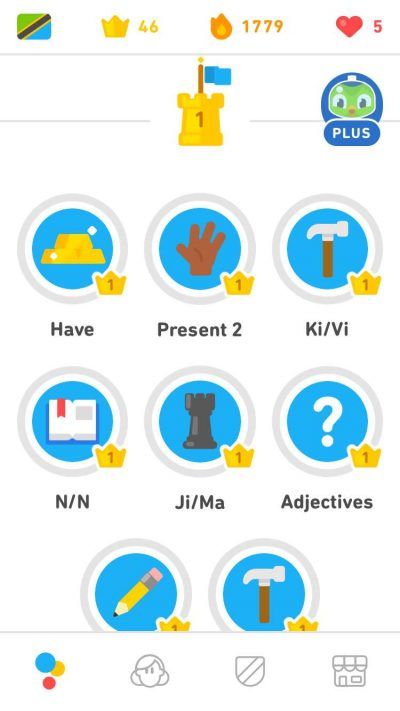
Lingots/Gems
You earn lingots (red gems on desktop)/gems (blue gems on smartphones) in multiple different ways: completing a new skill, watching video ads, hitting your daily goal, advancing to 1st, 2nd or 3rd place in a league, and winning a wager.
These can be used in the Duolingo Shop to kit out your Duo owl in new outfits, to buy extra lessons (like idioms), to bet on yourself that you’ll hit your daily goal 7 days in a row, to give to users who post helpful comments in the forum, or to freeze your streak.
Streak
The famous Duolingo Streak is where addiction meets competition! Your daily streak goes up every time you hit your daily goal. As long as you don’t miss a day of using the app, your streak will rise.
At the time of writing this my streak is currently 1779 days, meaning I haven’t missed a lesson in nearly 5 years! Though this might sound impressive, there are people out there who have much longer streaks than me. You can see other users’ streaks by clicking on their profiles.
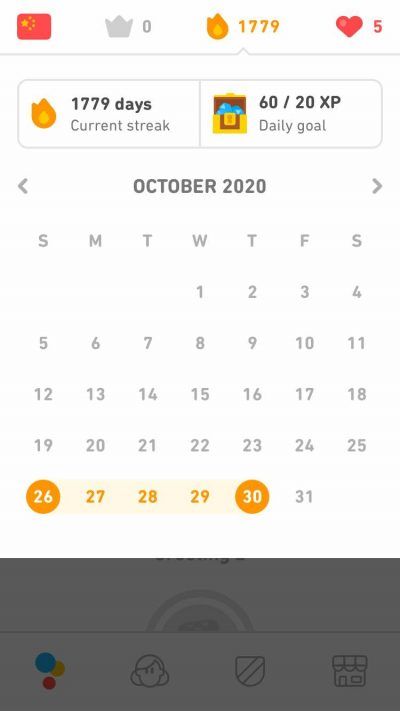
Trophies
You get trophies for completing certain challenges. You can’t do anything with them, but they do give you something to work toward.
Leaderboards and leagues
The more XP you earn, the higher up the weekly leaderboard you rise. There are 10 leagues, starting with bronze and ending with diamond. Your aim is to get into first place in the diamond league. It will require a lot of duolingoing, though!

Removing a language from Duolingo
You can remove languages by going to your settings. All of your lesson data will be deleted, though, so be certain that’s what you want.
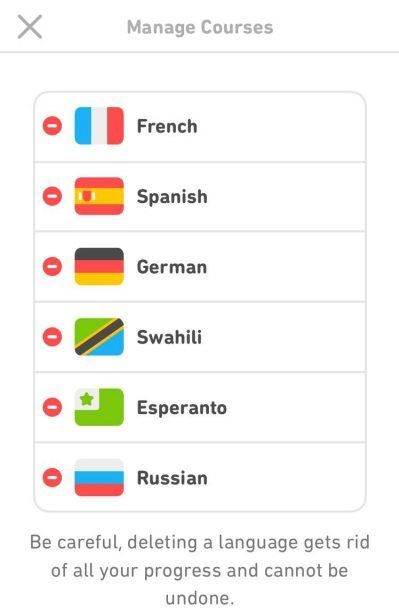
Now that we’ve seen the ins and outs of how the app works, let’s talk about how effective it is.
What Duolingo does well, and how it can help you
Duolingo is great for learning languages, in that, through the gamification approach, it teaches you in a fun, memorable way. It’s colorful, has loads of pictures, and uses native speakers for the listening exercises. You’re eased into sometimes very complicated grammar through example sentences, not a bunch of verbose explanations.
Completing a course will have exposed you to roughly 2,000 words in your target language, among them the most used words. This is incredible when you consider that most people use, on average, about 600 words regularly in their daily lives.
Vocabulary isn’t the only thing you need in order to use a language, however. But Duolingo takes care of some of the other stuff, too, by teaching you to form new sentences you haven’t been taught, which gets you thinking for yourself. It creates a strong foundation for you to build on, and sends you off into the world with the ability to, at the very least, have basic conversations in your new language.
When faced with languages with completely new writing systems, Duolingo makes sure you have the basics down before you move on. With symbol-based languages (like Japanese), right from the start you’re taught to recognize and pronounce them. This removes the elusiveness from them.
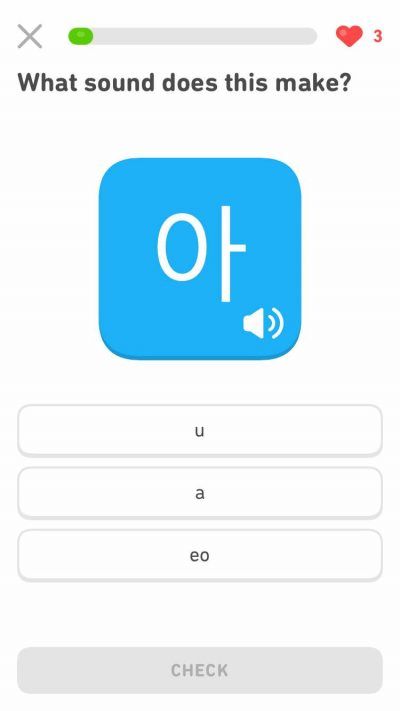
I have used Duolingo to teach me Russian from scratch, and it’s been amazing! I went from being completely unable to read or pronounce the Cyrillic alphabet, to being able to pronounce all the Russian words I encounter. All in the space of a few weeks.
The Tips feature is very useful in explaining the grammatical oddities and reasonings behind the languages. It helps to reinforce your understanding of them.
Where tips aren’t included, you can simply click on the discussion icon, and 9/10 your questions will have already been answered. The community is both helpful and entertaining, and you’ll find yourself learning so much more outside of the lessons.
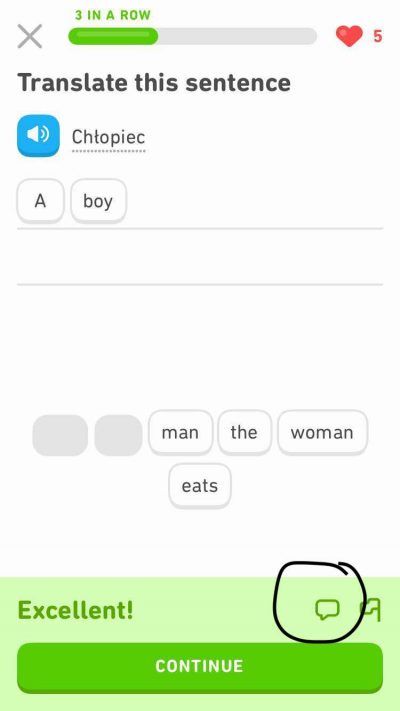
The number of languages on offer means there’s something for everyone. And Duolingo’s signature methods of teaching means some of the hardest languages out there (like Mandarin Chinese or Arabic) are broken down and made easier.
In order to give us all of this good stuff for free, Duolingo shows ads, but they aren’t too invasive and annoying; they won’t hamper your learning in any way.
What Duolingo needs to improve on
There are some downsides to the program. While not dealbreakers, they do make the learning process a little… clunky at times.
No audio
In the app, sometimes there is no audio, especially in some of the multiple choice questions. Where this happens, though, you can easily click the discussion tab, and an option to play the audio comes up at the top of the screen.
Unacceptable answers
Sometimes courses don’t include perfectly acceptable answers, and only allow for one or two variations. If you encounter this, you should report it to the team. This process is easy enough, though, and things are usually fixed promptly.
No landscape mode in the smartphone app
This is actually a major pet peeve of mine, especially since this feature did exist at one time, but has since been removed. I will never understand why Duolingo removed landscape mode, because portrait mode makes using the app quite difficult if you’re lying down. Please bring it back, Duolingo! I’ll pay you all the lingots I have!
No Duolingo Stories for other languages
I find the stories extremely helpful for improving my listening skills, and it’s a shame that they’re only available on a handful of languages. I know, though, that Duolingo are always adding new features and improving the app, so I’m sure more languages will eventually get them.
No Tips for all languages
The app doesn’t have Tips for all the languages, despite the desktop version having them. This needs to be implemented. Without the tips, you end up not knowing why certain things happen in the grammar, and when to use particular words. The community does step in, certainly, but official tips would be more useful.
Cannot use it offline unless you pay
Once upon a time, before the creation of Duolingo Plus, you could use the app offline, on new lessons, at least. Now you can’t. Not a big deal, but it would be nice to be able to do some practice in instances where you might not have Internet access.
You’ll learn the basics, but that’s about it
While what you learn on Duolingo sets a good foundation in a brand new language, there’ll be so much not covered that you’ll have to do more work outside the app. Again, not a big deal, and something you should have already been doing.
What’s the best way to use Duolingo?
Everyone has their own method; you will likely develop your own, too. For me, depending on the language, I like to spend as much time on the module as I need to before moving on. I’ll do loads of practice exercises until I’m confident in my ability to remember what I’ve learnt. This means that it takes me a lot longer than it might take others to complete a tree.
The people at Duolingo have suggested using what they call the “hovering” approach as the best way to use the program. You can read all about that here, on Duolingo’s official blog.
Some frequently asked questions about Duolingo
What level will you be at when you finish? How far does Duolingo get you?
Having used the program for several years, across a number of languages, I would say that, by the end of a course, you should be at A2 – B1 at most. B2 would be a stretch if solely using Duolingo. If combined with other materials and lots of speaking and writing practice of your own, B2 should be achievable.
Can you gain fluency solely with Duolingo? Will Duolingo make you fluent?
Duolingo is a powerful app, but using it alone will not make you fluent in any language.
What is possible is that you learn the basics, which makes it much easier for you to expand upon your knowledge through other material, like books, movies, shows, and speaking to natives. It is only through these other means, of interacting with the language naturally, that you’ll ever hope to become fluent. A language isn’t just short, fun exercises, it’s a living, breathing thing.
Is Duolingo a waste of time? Does it actually work?
In my opinion it’s not a waste of time, and it does indeed work, if you’re realistic about your expectations. There aren’t many free apps that can get you from zero knowledge in a language to conversational level by spending 30 minutes a day on it. You’ll pick up lots of new vocabulary quite quickly, but most importantly, it will stick.
It’s perfect for beginners, and doesn’t ever feel overwhelming. As long as you use it daily, you’ll definitely see results in a short space of time. Just a few months of using the app will likely teach you more than 5 years in school (trust me, I know this firsthand).
Is Duolingo good for learning Spanish, French, German, Russian, Japanese et al?
While I haven’t used the app on most of the languages, I can say that I’ve been impressed with the Spanish, German, Esperanto, Welsh, French and Russian courses.
Although I had been studying the former three independently, and used the app to solidify my knowledge, the latter three courses, French and Russian especially, were brand new for me, and they’ve been great.
I wasn’t as impressed with the Swahili course. There need to be improvements. Many words you click on don’t have audio, and the course is too short.
As for Japanese, this article by Team Japanese, gives an honest review of the course. You can also find plenty of information about all of the courses from learners in the Duolingo forum, where people regularly discuss the ins and outs, pros and cons.
Does Duolingo teach ASL?
Duolingo currently doesn’t teach American Sign Language or any other sign languages. However, they add new languages and lessons all the time. If there is enough demand and enough volunteers, a course will be made. My advice: put in your request by starting a new forum post.
Can Duolingo be used for school credit?
Although some schools have integrated Duolingo into their teaching, officially, no, Duolingo cannot be used for school credit. Currently, most schools do not recognize it as a genuine language course.
Lack of communication skills developed was cited as one of the main reasons why the course couldn’t be used. Which is ridiculous, considering you’ll learn so much more using it than you ever would in school. In fact, Duolingo claims that, “On average, it takes 34 hours of Duolingo to learn the equivalent of one semester of college”.
If not for credit, however, you will be able to boost your learning, and put yourself miles ahead.
Can you get Duolingo on Kindle Fire?
Not directly. You would need to sideload the Google Play app onto your Fire, then load Duolingo onto that. This guide from How-To Geek walks you through it.
Conclusion
Duolingo is a premium app that is totally free.
It can be extremely useful in getting an absolute beginner from no knowledge in a language to basic, conversational knowledge, and does so in an enjoyable, addicting way. For those at an intermediate level, it can help to strengthen the knowledge you already have.
You will get the most out of the app by using it regularly, possibly a few times a day, in order to keep refreshing your memory.
You can use it wherever you are, so long as there is internet connection, and do so in short, spaced out bursts, in order to fit it around your life.
You should not, however, rely on it for fluency, as you will be disappointed. Instead, combine it with other language acquisition activities. You must get into the habit of reproducing the language yourself, otherwise you will not be able to use it when having real-life conversations.


